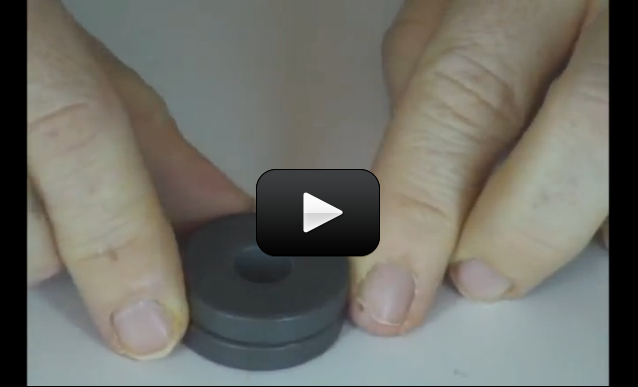Want to see a really neat way to get magnetic fields to interact with each other? While levitating objects is hard, bouncing them in invisible magnetic fields is easy. In this video, you’ll see how you can take two, three, or even four magnets and have them perform for you.
Are you ready?
Materials:
- 3 identical magnets
[am4show have=’p8;p9;p21;p48;p77;’ guest_error=’Guest error message’ user_error=’User error message’ ]
Download Student Worksheet & Exercises
Did you notice that if the north pole of the bottom magnet is up, then the south pole of the magnet stacked above it will be down? The stack holds together because opposites attract (north-south). You probably already knew that, right? But notice when you pull the top magnet to the side the bottom south face is repelled into the air above the north face of the fixed magnet. So what gives?
Remember that a magnet isn’t strictly north or south. There are field lines that connect the two poles. The field lines start at one end and swoop down to the other and back again like in this picture to the left, reversing from north to south as it does so. This is why the south face is repelled – because it’s actually the magnetic fields that are doing the repelling.
You can adjust your two bouncing magnets to have nearly the same ‘bouncy’ (frequency) by changing their distance apart. Notice that when one magnet starts bouncing, the magnetic field changes, which pushes and pulls on the other magnet. The two magnets interact with each other through their magnetic fields, pushing and pulling each other into resonance.

Once you’ve mastered two magnets, why not try three? Or four? What happens when you bring a conductor, like a thick sheet of copper, aluminum (cookie sheet or cake pan) nearby? The eddy currents created in the metal by the moving magnet created an opposing magnetic field that work to ‘brake’ the moving magnet and stop it from bouncing.
While this activity may seem a bit trivial (and a little fun), the idea of a magnetic field is one of the greatest leaps ever made in science. Scientist Michael Faraday imagined the idea that a magnet had not only a magnetic field, but that it cold push and pull on other magnets and moving electric charges. This crazy idea was so wild that it took many scientists a lifetime to come to terms with it… as it replaced an older idea from Newton that had stood for centuries.
And, as usually happens when someone has a new bright idea, others are quick to add to it. Shortly after Faraday’s idea about magnetic fields and electrical charges, Maxwell combined complicated mathematics (stuff you’ll only see at a university) into his four famous equations (Maxwell’s Equations) that describe all electric and magnetic fields.
Exercises
- Why does the magnet float?
- After you tap the floating magnet, does it vibrate for a short or long time? Why?
- Why do we stack the magnets first before trying to levitate them?
- How many magnets can you get to interact while floating?
- When you float two magnets above the main magnet, how do the floating magnets interact with each other? Why do they do that?
[/am4show]


No, just able to interact like in the video.
Do they have to be identical
Try it! What did you find out? How can you tell which end is N or S on a magnet?
Yes!
ahhhhhhhh I’ve got the first magnet but I can’t get the second one
it should be north and north are facing each other to levitate right
can they be round magnets
I got mine at Radio Shack and a hardware store. If you go to the unit shopping list, if they are hard to find items I will also post a link where you can order them online.
where do you get those round and rectangle magnets.
we have a book that says you can put a donut magnet on a pencil then 2 magnets about 30 degrees, do that on both ends then spin the pencil it wil go for a long time
it is awesome
this was really cool
it is cool i got it to work with all the magnets i had
Oops – sorry I missed your comment about making your own permanent magnets! Yes you can, but it’s REALLY hard and uses an intense heat source (not something you’ve have around the house) and a lot of patience to get the atomic domains to line up to form the magnetic field.
It’s a lot easier to take a strong magnet (rare earth work well) and stroke it along the length of an iron material, like a nail, screwdriver, or scissors to make a magnet. It’s not going to be nearly as strong, but you can do it. Did you see the instructions on how to make a permanent magnet NOT a magnet?
You can use different ones, though it’s usually easier if they are the same as shown in the video. Try it and let me know how it goes!
Can you use two of the same type of magnets and one different, or do you need three of the same type?
i have got to admit that is a good idea
Aurora, got a question…. Is there a way to make a magnet? I mean like a permenant magnet! Not with a nail like a REAL magnet!!!! It would be cool if we could make magnets 🙂 pppppplllllllllleeeeeaaaaassssssseeeeee 😀
Pretty please with science everywhere 😛
Raena (Age 10)
Yea!
Okay thanks. I got it to work now! 😀
-Charli(7th grader)
You might be able to if you turned them so a north faces up and the south points down. Keep trying! Science is like this sometimes… 🙂
My magnets are where the entire side is north and the other entire side is south. So that won’t work???? :/
-Charli(7th grader)
This one takes a little patience, as I am sure you are finding out. The location of the poles is important for the project. I used these magnets from Radio Shack, because each pole is on a large, flat side (if you lay the rectangular magnet flat on the table, the top part is one pole). The top surface is north and the bottom side is south. Other magnets have one entire end (both top and bottom of one half of the magnet) is north and the other is south, which won’t work for this project. What kind do you have?
Aurora!
I can’t get it to work! 🙁
I’ve tried 3 different shapes and sizes many times.
Plz help. 🙁
-Charli(7th grader)